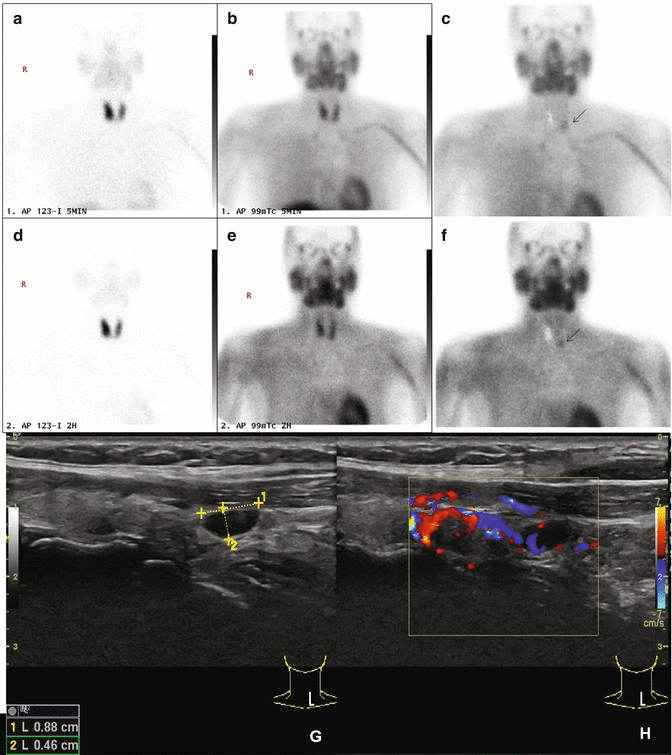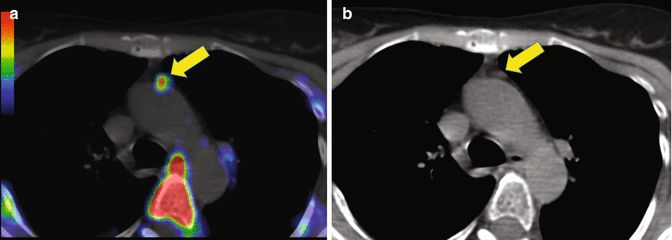Fig. 14.1
A 54-year-old woman with type 2 diabetes was investigated because of kidney stones. Her serum ionized calcium was markedly increased, 1.74 mmol/l (reference range 1.16–1.30 mmol/l), and also her plasma PTH was markedly increased, 275 ng/l (reference range 15–65 ng/l). She was scheduled for surgery because of severe PHPT. Neck ultrasound demonstrated an enlarged right thyroid lobe with nodules compatible with goiter, the larger one measuring 2.5 cm (panels a, b). 123I/99mTc-sestamibi scintigraphy (panels c–f) demonstrates an increased uptake in the left thyroid lobe both with 99mTc and 123I at 5 min (c, d) and at 2 h (e, f), respectively. At surgery, a parathyroid adenoma was found within the left thyroid lobe, which was resected, and the patient was cured

Fig. 14.2
A 56-year-old woman treated for breast cancer was screened for hypercalcemia. Her serum ionized calcium was increased, 1.42 mmol/l (reference range 1.16–1.30 mmol/l), and also her plasma PTH concentration was increased, 113 ng/l (reference range 15–65 ng/l). She was diagnosed with primary hyperparathyroidism. She underwent bone densitometry which revealed osteoporosis. She was scheduled for surgery and underwent 123I/99mTc-sestamibi scintigraphy (a–f) and neck ultrasound (g, h). Planar scintigraphic images in anterior view demonstrate 99mTc and 123I uptake at 5 min (a, b) and respective uptakes at 2 h (e, d) without parathyroid adenoma detection. The subtraction images at 5 min (c) and at 2 h (f) demonstrated abnormal uptake in the left inferior parathyroid gland (arrow). Neck ultrasound (g, h) showed a 5 × 9 mm tumor at the left inferior posterior thyroid lobe, which is compatible with a parathyroid adenoma
14.2.2 Selective Venous Sampling
Selective venous sampling (SVS) was introduced for localization of hyperfunctioning parathyroid glands in 1969 by Reitz and colleagues [13]. Results from studies evaluating the accuracy of this invasive technique have not been consistent. The range of positive predictive results has varied from 39 to 93 % [12, 14]. Most studies have been retrospective and have not included direct comparison with other techniques. Some of the differences in outcome are explained by selection bias (selected patients only or up to 100 % of patients included having single adenoma disease with exclusion of multiglandular disease). Schalin-Jäntti and colleagues prospectively compared the performance of SVS, planar scintigraphy with 123I/99mTc-sestamibi, 99mTc-sestamibi SPECT/CT, and 11C-methionine PET/CT in PHPT patients scheduled for reoperation and found that SVS was the least accurate technique with a high proportion of false predictive findings [11].
14.2.3 Planar Scintigraphy and SPECT/CT in Combination with Single or Dual Isotopes
As introduced by Coakley et al. in 1989, 99mTc-sestamibi scintigraphy has gained great popularity. Worldwide, this is probably the imaging modality used most often before primary surgery of PHPT [15]. Uptake of 99mTc-sestamibi is, however, not tissue-specific but is sequestered within mitochondria both in the thyroid and parathyroid tissue, as well as in the salivary glands and normal cardiac cells [16]. Imaging using the single-tracer technique is based on the different washout kinetics for thyroid and parathyroid tissue. While maximum thyroid gland activity is reached within 5 min, parathyroid activity is sustained with delayed washout, which allows for parathyroid imaging two hours after the injection [16]. Thyroid nodules may have a prolonged washout and thus cause false-positive findings when using the single-tracer technique.
99mTc-sestamibi can also be used in combination with iodine-123 (123I) or technetium-99 m pertechnetate (99mTcO4−), which are thyroid-specific isotopes. In this dual-isotope technique, the thyroid image is digitally subtracted from the 99mTc-sestamibi image and thus allows for the visualization of parathyroid tissue alone (Figs. 14.1 and 14.2). The EANM guidelines recommend the use of an additional thyroid-specific isotope over 99mTc-sestamibi imaging alone [17].
SPECT and SPECT/CT have gained much popularity for acquisition of abnormal parathyroid glands [18]. The combination of SPECT with CT allows for better anatomical identification of the abnormal gland. SPECT and SPECT/CT can also be performed either in combination with the single-isotope or dual-isotope method (Fig. 14.3). Using the single-isotope technique, Lavely and colleagues concluded that early SPECT/CT in combination with any delayed imaging performs better than planar scintigraphy or SPECT alone [19]. Tunninen et al. compared five parathyroid scintigraphic protocols in patients with primary or secondary hyperparathyroidism, including three scintigraphic protocols with dual-isotope (parallel-hole planar, pinhole planar, and SPECT/CT) and two with single-isotope (double-phase parallel-hole planar and SPECT/CT) and concluded that any dual-isotope protocol performs better than the single-isotope protocols [20].


Fig. 14.3
This female patient with PHPT underwent dual-isotope SPECT/CT with 123I and 99mTc 10 min after the 99mTc-sestamibi injection. The adenoma was not visible on transaxial fusion 99mTc-sestamibi imaging (a). Transaxial fusion subtraction imaging (b) revealed a parathyroid adenoma (arrow), which was also visible on low-dose CT imaging (c). At surgery, a parathyroid adenoma was found behind the left thyroid lobe. The patient was cured
A recent large retrospective study comparing the performance of dual- versus single-isotope 99mTc-sestamibi before primary surgery of PHPT demonstrated that dual-isotope 99mTc-sestamibi scintigraphy was significantly more accurate than 99mTc-sestamibi alone, with accuracies of 63.4 and 34.9 %, respectively [10]. Figure 14.2 demonstrates the 123I/99mTc-sestamibi scintigraphy findings in a patient with PHPT; while 99mTc-sestamibi imaging at 5 min and 2 h remained negative, subtraction imaging revealed an abnormal uptake in the left inferior parathyroid gland, compatible with a parathyroid adenoma.
14.2.4 PET/CT
11C-methionine PET/CT has good specificity for hyperfunctioning parathyroid compared to surrounding head and neck tissue [21]. The use of 11C-methionine PET has since been suggested for difficult cases of PHPT, with negative imaging results on conventional imaging [22–25]. 11C-methionine PET is not available in all centers and the complicated labeling procedure may be regarded as a limitation. A prospective study comparing the accuracy of five different localization techniques (planar scintigraphy with 123I/99mTc-sestamibi, 99mTc-sestamibi SPECT/CT, SVS, and 11C-methionine PET/CT) in complicated PHPT recommended planar scintigraphy with 123I/99mTc-sestamibi as first-line imaging before reoperation and concluded that 11C-methionine PET/CT provides additional information if 123I/99mTc-sestamibi scintigraphy remains negative [11]. Figure 14.4 demonstrates a case in whom an ectopically located parathyroid adenoma was located with 11C-methionine PET/CT before reoperation.
 < div class='tao-gold-member'>
< div class='tao-gold-member'>





Only gold members can continue reading. Log In or Register to continue
Stay updated, free articles. Join our Telegram channel

Full access? Get Clinical Tree


